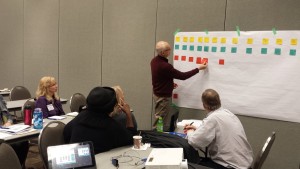 Journey mapping is a great way to visualize and truly understand your customer’s journey as they interact with your organization. But when you start a journey mapping project, how do you know where to start? Where do you investigate? It begins with a hypothesis.
Journey mapping is a great way to visualize and truly understand your customer’s journey as they interact with your organization. But when you start a journey mapping project, how do you know where to start? Where do you investigate? It begins with a hypothesis.
A frequent practice is to end a journey mapping process with a workshop, and that’s definitely a good idea. It cements the learning, and adds depth to your maps. It also helps create ownership with your internal teams. These workshops pull together the data that’s been gathered to create an immersive and empathetic view of the customer experience. But there’s another way to apply the principles of journey mapping, this time to the beginning of the process – hypothesis mapping.
The core idea of hypothesis mapping is the same as journey mapping – gathering teams and building a shared vision of your existing customer experience. However, as its name suggests, hypothesis mapping doesn’t use your customer’s voice, but instead gathers the ideas of your organization’s employees, using what they think the customer’s journey will look like to form the map. Not only does this give you a comprehensive idea of what your teams think your customers’ experience looks like, it also becomes valuable later on in the process.
But how should these hypothesis maps be used? First, they can be instrumental in guiding the research for when you actually talk with your customers. Understanding your organization’s internal perspective of customers can inform how to ask questions or even what questions to ask. And knowing the vision of your fellow employees can clarify your own vision, whether in agreement or opposition to it.
Your hypothesis maps are also critical late in the process, once you’ve collected the voice of your customer and created your journey maps. Compare employees’ hypotheses against the journey maps created from listening to your customers. Examine the differences between the two, and use these differences to help inform the recommendations you make to the company to improve your CX. You don’t want to use the difference to bludgeon your employees – “Here’s the truth! You’re wrong!” (although some do find that tempting). Instead, emphasize where they were right, and use that to then highlight areas where their internal view may have led them astray.
So hypothesis maps have many uses – but there are some potential uses that should be avoided, too. It might be tempting to show hypothesis maps to customers, to get their reactions to the organization’s view of them. In fact, we had this debate on the CXPA’s community forum a few months ago.
But sharing your hypotheses with customers is a bad idea. This artificially focuses the debate, so that your customers then react to the hypothesis maps, rather than thinking broadly about their journey.
One of the true sources of power in journey maps is understanding what your customers do outside of your “walls” that has a huge impact on what they do with you. For example, for one B2B client we found that the great majority of the sales journey happens before the potential client engages with our customer. Had we shared our client’s hypotheses, the conversation would have focused around the points that were in the hypothesis map – not on the broader journey. And we never would have discovered the rich information that we did.
Sharing your hypothesis limits the scope of your study, in turn blocking access to the customers’ true source of pain. If they’re merely reacting, they’re much less likely to share their own thoughts. That means you get less useful – and less interesting – data.
But if used well, hypothesis maps can be a great resource to guide research, understand where an organization is coming from, and ultimately to use in tandem with journey mapping to inform what choices to make to better your customers’ experience. Just keep them to yourself. Your customers will be happy to tell you the real story.



